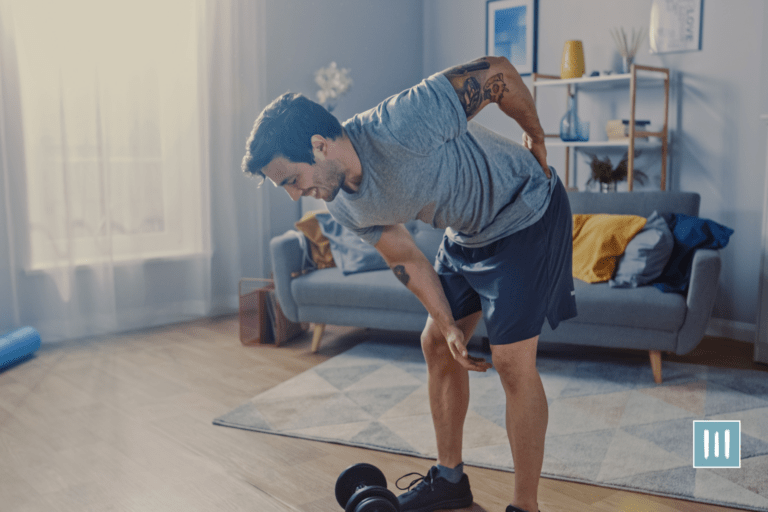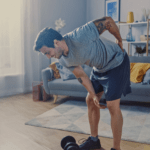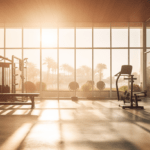Are you tired of being sidelined by injuries during your home workouts? It’s time to take charge and incorporate effective injury-prevention exercises into your routine. By dedicating just a few minutes to warm-up exercises, strengthening your key muscle groups, improving balance and stability, and incorporating stretching and flexibility exercises, you can significantly reduce your risk of injury and keep making progress toward your fitness goals.
Now, I know what you’re thinking. Who has time for all that? But trust me, investing in injury prevention exercises is the key to long-term success and mastery.
Think of it as your secret weapon to staying in the game and reaching new heights in your fitness journey.
So, let’s dive into the world of injury-prevention exercises for home workouts and discover the exercises that will help you stay strong, stable, and injury-free.
Key Takeaways
- Warm-up exercises, such as dynamic stretching and jumping jacks, are important for preparing the body for a workout and reducing the risk of injuries.
- Strengthening key muscle groups, like the lower body, chest, and core, is crucial for enhancing stability, power, and endurance.
- Balance and stability exercises, such as single-leg balance exercises and planks with leg lifts, are effective for improving coordination, core strength, and body control.
- Stretching and flexibility exercises, including hamstring stretches, quadriceps stretches, chest stretches, and hip flexor stretches, are essential for improving overall flexibility, preventing muscle imbalances, and reducing the risk of injury.
Warm-Up Exercises for Injury Prevention
You need to start your home workout with some warm-up exercises to prevent injuries. Warming up is important because it prepares your body for the workout ahead, increasing blood flow to your muscles and making them more flexible.
One effective warm-up exercise is a dynamic stretching routine. This involves performing stretches that mimic the movements you’ll be doing during your workout. For example, if you’re planning to do squats, you can start with some bodyweight squats to warm up your leg muscles and improve your range of motion.
Another great warm-up exercise is jumping jacks. Not only do they get your heart rate up, but they also engage multiple muscle groups, making them an efficient full-body warm-up. Jumping jacks help to increase your body temperature and loosen up your joints, reducing the risk of injury during your workout. Additionally, they’re a fun and energetic exercise that can help to get you mentally prepared for your workout.
Strengthening Exercises for Key Muscle Groups
Engage your muscles with targeted movements that build strength and resilience. Strengthening key muscle groups is essential for injury prevention and improving overall performance in your home workouts. By focusing on these specific areas, you can enhance your stability, power, and endurance.
Here are three effective exercises that will help you master your muscle strength:
- Squats: This compound exercise targets multiple muscles in your lower body, including your quadriceps, hamstrings, and glutes. Start by standing with your feet shoulder-width apart. Lower your body by bending your knees and pushing your hips back, as if you’re sitting back into a chair. Keep your chest up and your core engaged. Then, push through your heels to return to the starting position. Squats not only strengthen your leg muscles but also improve your balance and coordination.
- Push-ups: This classic exercise primarily works your chest, shoulders, and triceps, but it also engages your core and back muscles. Start in a high plank position with your hands slightly wider than shoulder-width apart. Lower your body by bending your elbows, keeping them close to your sides. As you descend, maintain a straight line from your head to your heels. Push back up to the starting position, fully extending your arms. To modify the exercise, you can perform push-ups on your knees or against a wall. Push-ups are an excellent upper-body exercise that builds strength and stability.
- Plank: This exercise targets your core muscles, including your abs, obliques, and lower back. Start by lying face down on the floor, then lift your body off the ground, resting on your forearms and toes. Keep your body in a straight line from your head to your heels, engaging your core muscles throughout. Hold this position for as long as you can, aiming for at least 30 seconds. Planks not only strengthen your core but also improve your posture and stability in other exercises.
Incorporating these strengthening exercises into your home workouts will help you develop the necessary muscle strength and resilience to prevent injuries and enhance your overall performance. Keep practicing these movements with proper form and gradually increase the intensity to continue challenging your muscles.
Balance and Stability Exercises
To enhance your at-home fitness routine, try incorporating balance and stability exercises for an added challenge. These exercises not only help to prevent injuries, but also improve your overall coordination, core strength, and body control. By challenging your balance and stability, you are pushing your body to adapt and improve, which can lead to greater mastery over your movements.
One effective balance exercise to try is the single-leg balance. Simply stand on one leg and try to maintain your balance for as long as possible. As you get more comfortable, you can add variations such as closing your eyes or standing on an unstable surface like a foam pad. Another great exercise is the plank with a leg lift. Start in a traditional plank position, then lift one leg off the ground while maintaining a straight back and engaged core. This exercise not only challenges your balance but also strengthens your core muscles.
Incorporating balance and stability exercises into your at-home Moment Flow Rope workout routine can help take your fitness to the next level. By challenging yourself in this way, you are pushing your body to adapt and improve, leading to greater mastery over your movements. So why not give it a try? Your body will thank you for it.
Stretching and Flexibility Exercises
Developing a regular stretching routine at home can greatly improve your overall flexibility and mobility. Stretching exercises help to elongate the muscles and increase their range of motion, which can prevent muscle imbalances, reduce the risk of injury, and improve your performance in other physical activities.
Here are four effective stretching and flexibility exercises that you can incorporate into your home workouts:
- Hamstring Stretch: Sit on the floor with your legs extended in front of you. Reach forward and try to touch your toes, keeping your back straight. Hold this stretch for 30 seconds and repeat on the other side.
- Quadriceps Stretch: Stand tall and grab your right ankle with your right hand. Gently pull your foot towards your glutes, feeling a stretch in the front of your thigh. Hold for 30 seconds and switch to the other leg.
- Chest Stretch: Stand with your feet shoulder-width apart and interlace your fingers behind your back. Straighten your arms and lift them up, feeling a stretch in your chest and shoulders. Hold for 30 seconds.
- Hip Flexor Stretch: Kneel on your right knee and place your left foot in front of you, with your knee bent at a 90-degree angle. Lean forward, keeping your back straight, until you feel a stretch in the front of your right hip. Hold for 30 seconds and switch sides.
Incorporating these stretches into your home workouts will not only improve your flexibility and mobility, but also help you achieve a greater sense of mastery over your body. By dedicating time to develop your stretching routine, you’re consciously working towards improving your physical abilities and preventing injuries. Keep practicing and challenging yourself, and soon you’ll notice significant improvements in your overall flexibility and mobility.
Recovery and Rest Days
Rest and recovery are vital for maintaining a strong and healthy body.
On your rest days, focus on activities that promote relaxation and rejuvenation. This could include gentle stretching, foam rolling, or even just taking a leisurely walk. By giving your muscles and joints a break, you’ll be able to come back to your workouts feeling refreshed and ready to tackle new challenges.
It’s also important to listen to your body and recognize when you need rest. If you’re feeling especially fatigued or experiencing any pain or discomfort, it’s a sign that your body needs a break. Don’t be afraid to take a rest day or modify your workouts to accommodate your needs.
Remember, rest is not a sign of weakness, but rather a crucial component of a successful fitness routine. Embrace the rest days and use them as an opportunity to recharge and come back stronger than ever.
Frequently Asked Questions
How often should I perform warm-up exercises before starting my home workout routine?
How often should you warm up before your home workout routine? Are you ready to unlock your full potential? By incorporating warm-up exercises into your routine, you’ll prime your body for optimal performance and prevent injuries.
Are there any specific strengthening exercises that can help prevent common injuries like sprained ankles or pulled muscles?
To prevent common injuries, try incorporating exercises like calf raises and lateral lunges into your routine. Strengthening your ankles and hips can improve stability and reduce the risk of sprained ankles or pulled muscles.
Can balance and stability exercises be beneficial for individuals of all fitness levels or are they more suitable for advanced athletes?
Balance and stability exercises are beneficial for individuals of all fitness levels. They not only help prevent injuries but also improve overall performance. By challenging your body’s stability, you’ll develop a strong foundation for mastering any fitness goal.
How important are rest days in injury prevention and muscle recovery, and how do I know if I am giving my body enough rest between workout sessions?
Rest days are crucial for injury prevention and muscle recovery. Listen to your body and pay attention to signs of fatigue, excessive soreness, or decreased performance. If you experience any of these, it’s a clear indicator that you need more rest between workout sessions.

















